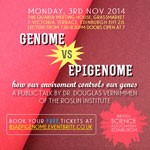The British Science Association Public Lecture
November 2014

"Genome vs Epigenome: the clay and the mould"
November 3, 2014
7:30 PM - 9:00 PM
by Doug Vernimmen, The Roslin Institute, University of Edinburgh
ABSTRACT
Epigenetics refers to inherited changes in how genes are switched ON and OFF without changing our DNA. It has been always thought that inherited characteristics rely on the genetic information (i.e. the genes) in the DNA, which is packaged as chromosomes inside the nucleus of each cell. Packaging proteins, called the nucleosomes, protect the DNA by playing a role of "bubble wrap". DNA associated with these nucleosomes is called the chromatin. If the DNA is well packed by these "bubbles" (condensed chromatin), genes will be switched OFF while if the DNA is uncovered (decondensed chromatin), genes are more likely to be switched ON. The level of compaction of these nucleosomes is influenced by chemicals that associate with them. Some chemicals also interact directly with the DNA. The presence (or absence) of these chemicals is under the influence of the environment. Therefore, the way the genetic information is executed does not rely entirely on the sequence involving the four bases A, T, G, C in the DNA, but also depends on the environment (e.g. food, stress, physical activity etc.). The most striking example is the case of identical twins (identical DNA sequence), who appear identical during childhood, but become more distinct during their adult life. Such twins are the perfect example highlighting the influence of the environment on the genetic information.
On the first Monday of most months, the British Science Association hold a free public lecture at the Quaker Meeting House near the Grassmarket in central Edinburgh.
Doors open at 7pm, with lectures running from 7:30-8:30pm.

